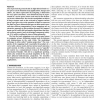Free Online Productivity Tools
i2Speak
i2Symbol
i2OCR
iTex2Img
iWeb2Print
iWeb2Shot
i2Type
iPdf2Split
iPdf2Merge
i2Bopomofo
i2Arabic
i2Style
i2Image
i2PDF
iLatex2Rtf
Sci2ools
CACM
2010
2010
Faster dimension reduction
Data represented geometrically in high-dimensional vector spaces can be found in many applications. Images and videos, are often represented by assigning a dimension for every pixel (and time). Text documents may be represented in a vector space where each word in the dictionary incurs a dimension. The need to manipulate such data in huge corpora such as the web and to support various query types gives rise to the question of how to represent the data in a lower-dimensional space to allow more space and time efficient computation. Linear mappings are an attractive approach to this problem because the mapped input can be readily fed into popular algorithms that operate on linear spaces (such as principal-component analysis, PCA) while avoiding the curse of dimensionality. The fact that such mappings even exist became known in computer science following seminal work by Johnson and Lindenstrauss in the early 1980s. The underlying technique is often called "random projection." T...
| Added | 09 Dec 2010 |
| Updated | 09 Dec 2010 |
| Type | Journal |
| Year | 2010 |
| Where | CACM |
| Authors | Nir Ailon, Bernard Chazelle |
Comments (0)

